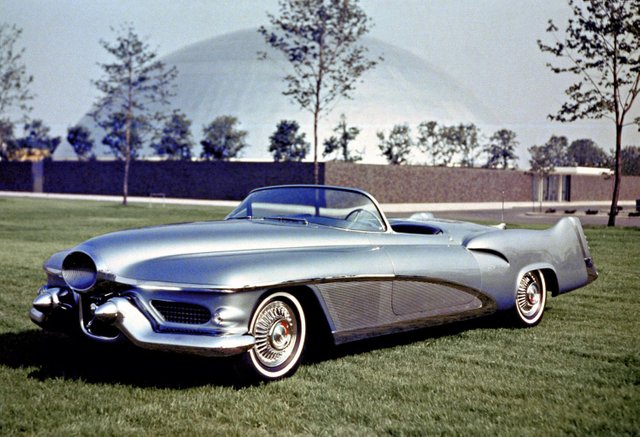Not For Sale: 5 of the most significant cars that have never hit the open market

These days it seems like most old cars gain some degree of notoriety for trading hands for huge sums of money. However, the recent announcement of the upcoming auction of Janis Joplin’s Porsche – which never left Joplin’s family after her death – got us thinking: What other famous and significant cars out there have never gone to auction, never appeared in a classified ad, or never been available for the general public to make an offer on them? As it turns out, there’s a good number of such vehicles, so we’ve whittled the list down to 10 – this is the Internet, after all, which seems to run on all-caps troll rants and top 10 lists – with several honorable mentions thrown in for good measure.
1951 GM Le Sabre
One of the first GM dream cars, the XP-8 Le Sabre was Harley Earl’s followup to the Buick Y-Job of 1938 and showcased a number of advanced technologies. Not once did it leave GM’s ownership and today it remains in the GM Heritage Collection. Honorable Mention: Well, there’s the aforementioned Y-Job, which also remains in the GM Heritage Collection, as well as a number of other dream cars and Motorama cars also in the collection, including the Firebird I, II, and III gas-turbine cars.

1886 Benz Patent Motor Wagen
Karl Benz’s three-wheeler often gets credit as the first internal-combustion engine-powered automobile, largely thanks to a neverending marketing push by Daimler-Benz throughout the years and in part due to the extensive documentation of its genesis. Benz began to market versions of his Patent Motor Wagen a couple years later, but held on to the original until 1906, when he donated it to the current owner and caretaker of it, the Deutsches Museum. Replicas of it abound and trade hands frequently these days. Honorable Mention: Another 19th-century proto-car which never got sold off, Henry Ford’s 1896 Quadricycle remained in Mr. Ford’s possession until well after he founded Ford Motor Company in 1903. He eventually donated it to what became The Henry Ford, where it remains today. And then there’s Nicolas-Joseph Cugnot’s fardier a vapeur, which well predates both Benz’s and Ford’s accomplishments and has only had two owners: the French Arsenal in Paris from 1770 to 1800 and the Musée des Arts et Métiers from 1800 to today.
 Photo by Jim Donnelly.
Photo by Jim Donnelly.
1911 Marmon Wasp
The car that won the first Indianapolis 500 with Ray Harroun at the wheel certainly qualifies as significant, even if it weren’t for its early stab at aerodynamics and Harroun’s rear-view mirror innovation. Marmon, and later Marmon-Herrington, frequently showed the car off and made parade laps with it in the decades after the win, and it only made sense as one of the earliest acquisitions for the Indianapolis Motor Speedway’s Hall of Fame Museum, established in the mid-1950s. Repairs to its engine, which suffered damage during a parade lap on the IMS’s centennial, are reportedly nearing completion. Honorable Mention: Like the Marmon Wasp, the first American-designed, built, and piloted car to win the 24 Hours of Le Mans, the 1967 Ford GT40 Mk IV, spent a few years on the publicity trail after its historic victory and ultimately ended up in a museum, in this case The Henry Ford, which has made an incredible effort to preserve it in race condition.

Photo by Lee Raskin.
James Dean’s 1955 Porsche 550 Spyder
By now, pretty much every car enthusiast, whether a fan of Porsches or not, knows all the details of how James Dean and his Porsche, nicknamed “Little Bastard,” came to grisly ends on a remote California road in September 1955. Many also seem to know the post-mortem legend of the Porsche, which mysteriously disappeared and reportedly caused mayhem and carnage as pieces of it trickled down to other cars. Reports pop up from time to time that somebody somewhere knows exactly where the car is, but to date no independently verified proof has surfaced with those reports. If the remains of the car do still exist, the owner(s) certainly hasn’t let the world know by putting them up for sale. Honorable Mention: This one’s kind of a red herring, given that it’s been missing for decades, and plenty of other missing vehicles could technically be eligible for this list – cars like the last Corvair, the Corvette Nomad, and even Admiral Byrd’s Snow Cruiser.
 Photo by the author.
Photo by the author.
Carroll Shelby’s 1962 Shelby Cobra CSX2000
The only prototype for the Shelby Cobra, CSX2000 probably saw more show daises and magazine photographer’s camera lenses than any other Cobra. While it famously received several repaints early on thanks to Carroll Shelby’s unorthodox publicity methods, these days it wears an older blue coat of paint and remains unrestored. After Shelby’s death in 2012, CSX2000 remained with his company, Shelby American. Honorable Mention: There’s probably a handful of other real-deal Shelby Cobras still in their original owners’ hands or passed down to family members, but none as widely known as jazz musician Herbie Hancock’s 1962 Shelby Cobra CSX2006, which he’s said he’ll never sell because he bought it with the first real money he made as a professional musician and this “it will never mean as much to anyone else who owns it as it does to me.
Excellent post!
Hi! This post has a Flesch-Kincaid grade level of 13.9 and reading ease of 55%. This puts the writing level on par with academic journals.